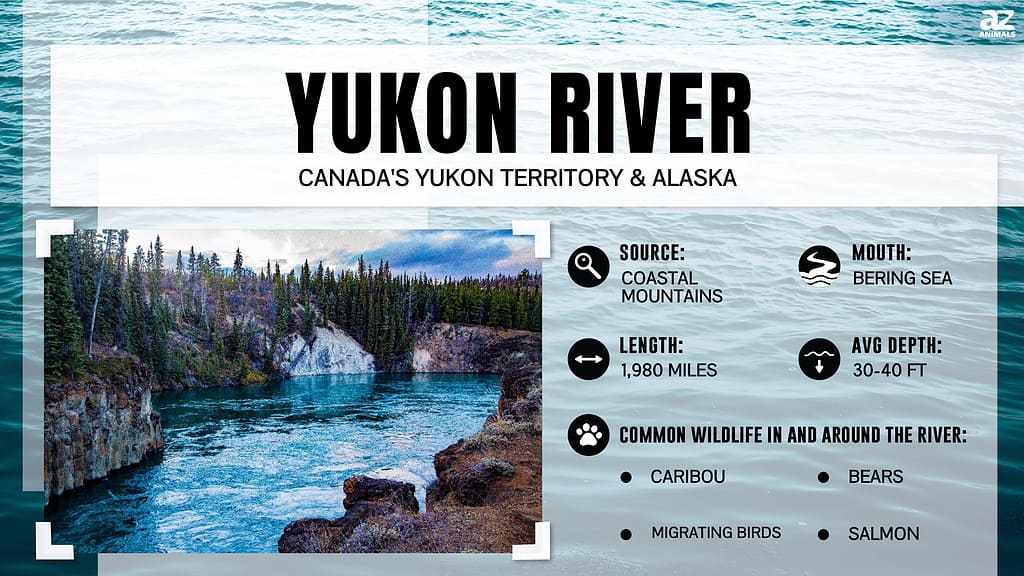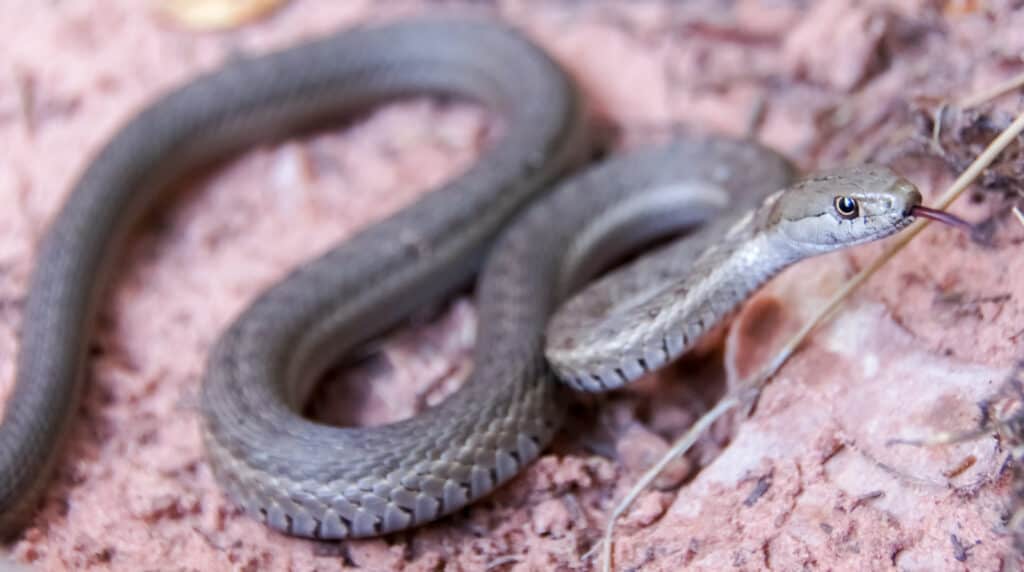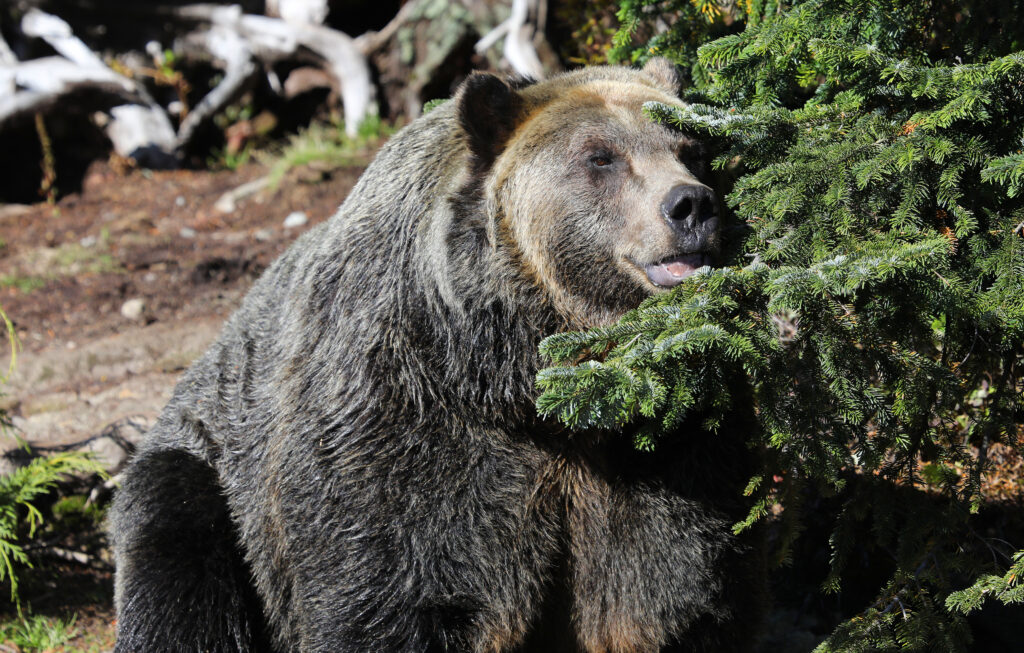A river of untamed beauty weaves its way over enormous sections of the northern geography of North America beneath the breathtaking wildness of the Yukon, where glaciers chisel their way through rocky cliffs. The Yukon River, a vital resource for both humans and animals, is teeming with a diverse array of life that lure both explorers and nature lovers. Whether or not it is safe to enter its alluring waters, though, is a pressing concern.
The answer is not as simple as one may anticipate. The river’s unspoiled beauty could entice the brave, but a safe and satisfying trip depends on a careful grasp of the river’s unique qualities and the wildlife that swims within its waters.
In this article, we’ll shed some light on this wildlife’s function within the Yukon River ecosystem and the safety precautions that those who want to swim in its waters should take into account. To start, let’s look into what exactly the Yukon River is and some history behind it.

What is the Yukon River?
The legendary Yukon River flowers through the central region of North America. It connects the wildness of Canada’s Yukon Territory with the U.S. state of Alaska across a great distance and through beautiful scenery.
Location
In Northern British Columbia Canada’s Coastal Mountains is where the Yukon River begins. From there, it travels across the Yukon Territory in a northwesterly direction, passing the territory’s capital Whitehorse before entering Alaska. The Bering Sea is eventually where it empties, not far from the city of Nome in Alaska. The river is one of the longest in North America because of its length, which is over 1,980 miles.
Depth and Length
The Yukon River is one of the world’s largest waterways due to its length. Its majesty is demonstrated by its calculated length of 1,980 miles in Canada and the United States. The river’s typical depth fluctuates along its course and can range from three to 50 feet deep, depending on the region and time of year. One of the deeper rivers in North America, it has plunged to an astonishing 130 feet at its deepest point in the past.
Historical Significance
The Yukon River had a significant role in history, notably during the late 19th-century Klondike Gold Rush. Following the discovery of gold in the Klondike region in 1896, thousands of prospectors ventured through the perilous voyage across the icy waters of the river in pursuit of riches. During this time, the river functioned as the main thoroughfare for transportation, enabling miners to reach the goldfields and move their priceless treasures downstream.
Just as well, for thousands of years, the Yukon River has provided a lifeline for the Indigenous cultures who have lived in the area. The resources of the river have been essential for sustaining native communities, including the Gwich’in, Han, and Yupik, as well as for commerce and cultural activities. These communities continue to place a great deal of importance on the river.
Unique Qualities
The Yukon River is very intriguing due to several unique characteristics. Its pure waterways traverse a variety of environments, including rocky mountains, boreal forests, vast tundra, and marshes. Numerous species of migrating birds, moose, caribou, and bears may all be seen along its banks.
Just as well, the river provides superb recreational opportunities, drawing tourists and outdoor lovers from all over the world. Adventurers have the option of setting out on exhilarating canoeing and kayaking trips where they may take in the stunning scenery and treacherous rapids. Abundant salmon species flow through the Yukon River, where Chinook, coho, and chum salmon move upstream to breed. This provides an excellent opportunity for fishers and anglers.

Chinook salmon (pictured) are found in abundance in the Yukon River.
©Martin Rudlof Photography/Shutterstock.com
Water Pollution in the Yukon River
Unfortunately, a significant water contamination catastrophe is plaguing the Yukon River, which is usually renowned for its pristine beauty and ecological importance.
Seriousness of Pollution
The Yukon River’s poisoning is a serious threat to the ecosystem and the populations who rely on its supplies. Heavy metals, herbicides, and industrial chemicals are just a few of the contaminants that have gotten into the river, endangering the sensitive ecosystems there. The effects are widespread and have an impact on aquatic life, animals, as well as the health and welfare of indigenous tribes that depend on the river for their daily needs and cultural traditions.
Causes of Pollution
The water contamination situation in the Yukon River is caused by several reasons. Toxic compounds are released into the water by industrial processes like mining and logging. Pollutants including fertilizers, pesticides, and sewage are introduced into the river system by runoff from urban areas and agricultural operations. Climate change makes the issue worse since it may worsen erosion, sedimentation, and the discharge of pollutants into rivers by increasing temperatures and altering precipitation patterns.
Remedial Efforts
In response to the pollution disaster, several actions are being taken to repair the harm done to the Yukon River. Environmental organizations, Native American tribes, and government agencies are collaborating to reduce pollution and rehabilitate the river.
Regulation and Law
To reduce industrial pollution, stricter rules and laws have been established. New projects must do environmental impact analyses to ensure that any possible environmental concerns are identified, evaluated, and reduced. To further restrict the discharge of dangerous compounds into the river, wastewater treatment regulations and pollutant discharge licenses have been put in place.
Community Involvement and Education
Initiatives are being made to include neighborhood groups and educate people about the value of preserving the Yukon River. Residents, businesses, and tourists are informed about the effects of pollution and the actions they may take to reduce their ecological imprint through educational programs and seminars. Encouragement of ethical behavior, including correct waste disposal and a reduction in chemical usage, aids in the prevention of pollution at its source.
Water Monitoring and Research
Comprehensive water monitoring procedures are in place to address the pollution situation efficiently. These projects monitor water quality, pinpoint the causes of contamination, and assess how well mitigation measures work. Studying the long-term effects of pollution on aquatic life and ecosystems can help researchers develop effective cleanup solutions.
Restoration and Conservation
Current restoration efforts seek to restore polluted sections and increase the river’s toughness. Restoration of habitat, erosion management, and the reintroduction of indigenous species are some of the tasks included in these programs. By creating protected areas and using sustainable land management techniques, conservation initiatives aim to maintain the river’s natural purity and stop additional pollution.
Wildlife Found Swimming in the Yukon River
The Yukon River is home to a wide variety of animal species in addition to being a magnificent waterway. The river sustains a thriving environment from its headwaters to its estuary.
Snakes Along the Yukon River
Compared to other regions of North America, the Yukon River region does not have as many snakes, partly because of the region’s frigid environment. Nevertheless, a few species do exist there and have adapted to the particular environmental circumstances.
The Western Terrestrial Garter Snake, one famous species located close to the river, is one such location. These colorful non-venomous snakes are frequently spotted soaking in the sun on the banks of rivers or nearby fields. They are essential to the ecology because they keep rodent numbers under control.

The Western Terrestrial Garter Snake (pictured) is one of the few snake species found near the Yukon River.
©iStock.com/yhelfman
Fish in the Yukon River
Many different fish species play important roles in the river’s ecosystem and support nearby settlements, making the Yukon River famous for its thriving fish populations.
Chinook Salmon
The Chinook salmon is a famous species found in the Yukon River. They traverse almost 2,000 miles in an astonishing migration from the Bering Sea to their spawning sites while braving strong currents. Both Indigenous communities and recreational fishers place a great deal of emphasis on these enormous fish since they are an essential food supply for other creatures.
Coho Salmon
Another important species in the Yukon River is the coho salmon or silver salmon. They have an amazing life cycle and spend part of their time in the ocean before returning to freshwater streams to breed. Because of their flavor and attraction for sport fishing, fishermen seek out coho salmon.
Arctic Grayling
The Yukon River is home to this unusual fish species. This fish thrives in the chilly, crystal-clear waters of the river and is recognized by its colorful, sail-like dorsal fin. Its beauty and readiness to fly out of the water make it a favorite catch for fishermen.
Animals That Can Pose Hazards
Even though the Yukon River is home to a wide variety of species, it’s crucial to be cautious of any dangers, especially for those going into the wilderness near the water. Some of the local wildlife may be dangerous if interactions are not handled carefully.
Bears
Grizzly bears and black bears are in large numbers in the Yukon River area. Even while these animals are intriguing to watch from a distance, if not handled carefully, they may be harmful. To reduce the possibility of running into bears, visitors can take safety measures that include carrying bear spray, making noise when trekking, and properly storing food.

Grizzly bears (pictured) and black bears spend a lot of time near the coast of the Yukon River.
©Jacqui Martin/Shutterstock.com
Wolves
You may find wolves in more distant sections of the Yukon River basin. Despite the rarity of attacks on people, it is important to use caution and refrain from approaching or feeding them. To safeguard the safety of both wolves and people, observe these wonderful creatures from a safe distance.
The Yukon River is home to a wide range of species, demonstrating the complex web of life that depends on this well-known stream. Along the riverbanks, you may see snakes like the Western Terrestrial Garter Snake, but the Chinook and coho dalmon as well as the unusual Arctic grayling are the true aquatic stars of the area. Visitors must, however, be cautious when exploring the area and be mindful of any possible dangers, such as wolves and bears. We can enjoy and live in harmony with the wildlife that inhabits the Yukon River if we respect the natural environment and all of its inhabitants.
Other Hazards in the Yukon River
While swimming in the Yukon River can be a refreshing and enjoyable experience, it’s important to be aware of potential hazards that may arise. Apart from water pollution, bears, and wolves, there are a few other hazards one may encounter while swimming in the Yukon River.
Cold Water Temperatures
The Yukon River’s waters can be exceptionally cold, especially in the northern reaches and during certain times of the year. Even during summer months, the river’s temperature is chilly, posing a risk of hypothermia for unprepared swimmers. It’s crucial to be aware of the water temperature and ensure proper safety measures, such as wearing appropriate swimwear and limiting exposure to cold water.
Strong Currents and Rapids
The Yukon River features various sections with strong currents and rapids. Particularly difficult in certain stretches where the river narrows or encounters rocky terrain. These swift currents can pose a significant risk to swimmers, even experienced ones. It’s essential to exercise caution and avoid swimming in areas with strong currents, as they can quickly overpower even strong swimmers.
Underwater Hazards
While swimming in any river, including the Yukon River, it’s crucial to be mindful of potential underwater hazards. Submerged rocks, tree branches, and debris can create obstacles that may cause injuries or entanglement. Take care to avoid diving or jumping into unfamiliar areas to prevent collision with unseen objects beneath the water’s surface.
Floating Debris
The Yukon River, like many other rivers, may carry floating debris, including logs, branches, and other natural or man-made items. These objects can pose risks to swimmers, as they may cause injury upon collision or create entanglement hazards. It’s important to be observant and avoid areas with significant amounts of floating debris, particularly during periods of high water flow.
Changing Water Levels
The Yukon River’s water levels can fluctuate, especially during spring runoff or after heavy rainfall. These changes can affect the river’s depth and currents, potentially creating hazardous swimming conditions. Swimmers should be cautious and avoid swimming during periods of rapid water level changes. It may be difficult to predict or navigate the altered conditions.
Lack of Lifeguard Services
It’s important to note that the Yukon River generally does not have lifeguard services in place, especially in remote or less populated areas. Swimmers should be self-aware, capable swimmers, and exercise personal responsibility for their safety. Having a swimming buddy or informing others of your plans can also be beneficial in case of an emergency.
Is It Safe to Swim in the Yukon River?
Swimming in the Yukon River can be safe under certain conditions. It’s important to exercise caution and take appropriate measures to ensure your safety. Here are some guidelines for visitors to stay safe while swimming in the Yukon River:
- Assess the Conditions – Before entering the water, assess the current conditions of the river. Consider factors such as water temperature, currents, and weather conditions. If the water appears rough, has strong currents, or if there are hazards present, it’s best to avoid swimming altogether.
- Choose Safe Swimming Areas – Select areas with a swimming designation or sections of the river where swimming is allowed and considered safe. These areas may be indicated by signs or commonly known by locals. Avoid areas with strong currents, rapids, or where submerged hazards are present.
- Swim with a Buddy – It’s always recommended to swim with a companion. Especially important in natural bodies of water like the Yukon River. Having a swimming buddy increases safety and assists in case of an emergency.
- Be Mindful of Water Temperature – The Yukon River can have cold water temperatures, even during the summer months. Be aware of the potential for hypothermia and limit your time in the water accordingly. Consider wearing a wetsuit or other appropriate swimwear to provide insulation.
- Respect Local Guidelines – Pay attention to any guidelines or regulations set by local authorities regarding swimming in the Yukon River. These guidelines are often in place for public safety and one should follow them.
Remember, natural bodies of water like the Yukon River can be unpredictable. It’s important to exercise caution and prioritize your safety. Always use your best judgment. Be mindful of the conditions and potential risks associated with swimming in a river environment.
The photo featured at the top of this post is © iStock.com/HeatherECampbell
Thank you for reading! Have some feedback for us? Contact the AZ Animals editorial team.







